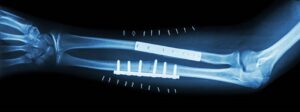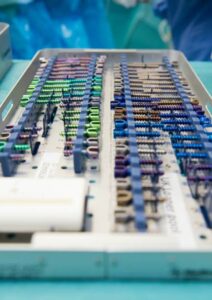Orthopedic bone screws are small, yet critical orthopedic implants used by surgeons. They are integral parts of orthopedic surgeries, leveraged for the internal fixation of bones/ fractures, joint fixation, correction of deformities, and the treatment of other orthopedic conditions.
Known to have been used for over 100 years, orthopedic bone screws as implants have undergone a sea of transformation. This is all thanks to clinical innovations and advancements in the design, manufacturing methods, materials used, functionality, precision, and other properties of orthopedic bone screws. These clinical innovations and advancements have enabled surgeons to enhance patient outcomes, reduce surgical complications, improve the overall effectiveness of the implants, and transform the quality of life of countless patients.
In this article, we will delve into the world of orthopedic bone screws, the clinical innovations and advancements over the years, and the major orthopedic bone screw types.
Orthopedic Bone Screws: Enhancing Stability and Healing
Orthopedic screws or orthopedic bone screws are critical orthopedic implants without which it is impossible to perform ortho surgeries. They are used alone to enable bone-to-bone or bone-to-tissue fixation, or in combination with plates and trauma implants.
Orthopedic bone screws offer great stability and support to bones to ensure they heal correctly. They help correct deformities, address pain, improve function, and minimize complications. With ongoing advancements, orthopedic surgeons have a wide array of bone screws (discussed later in the blog) to choose from, ensuring patients receive the best possible care and improved quality of life.
Even though they follow the same mechanical principles as regular screws, orthopedic bone screw implants are made with corrosion-resistant, sturdy, and durable materials such as titanium and stainless steel. Their design is modified to meet the needs of the human anatomy and surgical procedures in which they are used. Their design helps ensure that patients face the least possible trauma to surrounding soft tissues from orthopedic surgeries.
The Evolution of & Clinical Innovations in Orthopedic Bone Screws
The screw was invented in the 3rd century BC by Archimedes but started being used for fixation only begun after over 1000 years. The use of screws for surgeries began only after 1912 when William O. Sherman published his recommendations of using screws for bone fixations and designed the Sherman plate with round holes for screws. So, the first mention of the use of orthopedic bone screws for broken bones was over 100 years ago.
Evolving Design of Orthopedic Bone Screw Implants
Robert Danis, who designed the compression plate, recommended 3 key changes to the machine screws to make them suitable for bone fixation namely – altering the thread diameter to a 3:2 ratio, reducing the thread surface area to one-sixth of a regular screw, and using a buttress thread design to increase the pull-out strength as opposed to a V-shaped thread design.
Further innovations led to the development of low-profile orthopedic bone screws. Researchers have studied the possibility of eccentric bone screw placements through oval holes in plates. The changes in screw head design have reduced the risk of slippage.
The locking screw technology ensures greater implant stability by locking the screw head to the plate/rod. The risk of screw loosening/ slippage is minimal as a result, improving the fixation of fractures and bettering the bone healing process.
Expandable bone screws are designed to adjust after implantation. This innovation enables surgeons to finetune and adjust the compression or distraction of bone segments after surgery.
The developments in technology and production processes have enabled orthopedic bone screw manufacturers to customize screws to suit patient anatomies and specific surgical necessities. 3D printing, additive manufacturing, CNC precision machining, AI, rapid prototyping, and designing software, in particular, are enabling this advancement.
Materials Used
Stainless steel was introduced for the manufacture of bone screws in 1926 and titanium alloys in the 1970s. These metals are corrosion-resistant, biocompatible, and sturdy. Further, titanium is lighter than most other metals. Both these metals help reduce the chance of complications and implant rejection in patients while ensuring that the orthopedic bone screw surgical implant is durable.
Today, we also have biodegradable orthopedic bone screws which gradually degrade as the bone heals, eliminating the need for another procedure to remove the hardware from the body. While reducing the risk of infection and complications, it also makes the recovery process simple and seamless.
Some orthopedic bone screws are also available with antimicrobial coatings to reduce the risk of infection at the surgical site.
Orthopedic Bone Screw Types
As clinical innovations and advancements take place at a rapid pace, we have a growing number of orthopedic bone screw types. Here is a look at the key orthopedic bone screw types.
Cancellous Screws
Cancellous screws are self-tapping screws with a coarse thread design, apt for the fixation of soft/ spongy bones such as the cancellous bone. These have a larger pitch, a smaller number of threads, and are available in partially and fully threaded variations. These orthopedic bone screws offer great compression and enable effective fixation of fractures in soft bones found near the tibia and femur.
Cortical Screws
Cortical screws have a finer thread pattern, a smaller pitch, and a larger number of threads. These are fully threaded orthopedic bone screws apt for the fixation of the denser cortical bones, the thick outer surface of bones covering the bone cavity. They offer excellent stability in fixing fractures in hard bone tissues.
Cannulated Screws
Cannulated screws are orthopedic bone screws with a hollow center that allows the guide wires/ guide pins to be inserted for precise placement on the bones. Used in minimally invasive procedures and fracture fixation, these are known to minimize soft tissue damage.
Malleolar Screws
Malleolar screws are specialized orthopedic bone screws used to treat fractures in the ankle and stabilize the malleoli (the bony protrusions on either side of the ankle joint). Their trocar tip design enables surgeons to insert it without tapping and/or drilling it.
Herbert Screws
Herbert screws are specialized orthopedic bone screws leveraged for the internal fixation of broken small bones and cartilages including the hand and wrist. They are headless and can be inserted without any protrusions, ensuring minimal tissue irritation.
The Best Orthopedic Bone Screw Implants
If you are looking for the best orthopedic bone screws, your search ends here. Gesco is a leading orthopedic implant manufacturer offering a wide range of precise, OR-ready, premium grade orthopedic bone screws. Head onto our website to find out more.



